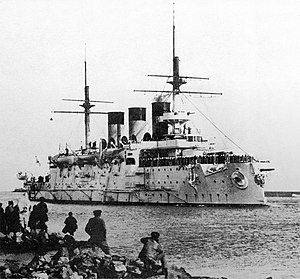 Oslyabya leaving Bizerte, French Tunisia, 1903
| |
| History | |
|---|---|
| Name | Oslyabya |
| Namesake | Rodion Oslyabya |
| Builder | New Admiralty Shipyard, Saint Petersburg |
| Cost | 11,340,000 rubles |
| Laid down | 21 November 1895[Note 1] |
| Launched | 8 November 1898 |
| In service | 1903 |
| Fate | Sunk at the Battle of Tsushima, 27 May 1905 |
| General characteristics | |
| Class and type | Peresvet-class pre-dreadnought battleship |
| Displacement | 14,408 long tons (14,639 t) |
| Length | 434 ft 5 in (132.4 m) |
| Beam | 71 ft 6 in (21.8 m) |
| Draft | 26 ft 3 in (8.0 m) |
| Installed power |
|
| Propulsion | 3 shafts, 3 triple-expansion steam engines |
| Speed | 18 knots (33 km/h; 21 mph) |
| Range | 6,200 nmi (11,500 km; 7,100 mi) at 10 knots (19 km/h; 12 mph) |
| Complement | 27 officers, 744 enlisted men |
| Armament |
|
| Armor | |
Oslyabya (Russian: Ослябя) was the second of the three Peresvet-class second-class pre-dreadnought battleships built for the Imperial Russian Navy at the end of the nineteenth century, although construction delays meant that she was the last to be completed. The ship was part of the Second Pacific Squadron sent to the Far East during the Russo-Japanese War of 1904–05, and served as the flagship of Rear Admiral Baron Dmitry von Fölkersam. Oslyabya was sunk on 27 May 1905 at the Battle of Tsushima, and was the first all-steel battleship to be sunk by naval gunfire alone. Sources differ on the exact number of casualties, but over half her crew went down with the ship.
Cite error: There are <ref group=Note> tags on this page, but the references will not show without a {{reflist|group=Note}} template (see the help page).